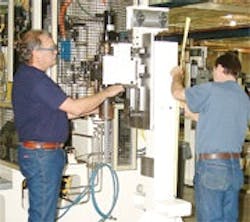Global Equipment Builder Designs Customized Machines With Standardized Processes and Tools
Assembly & Test Worldwide (ATW, www.assembly-testww.com) is a privately held global assembly and test capital-equipment manufacturer headquartered in Dayton, Ohio, with sites founded as far back as 1933. With about 550 employees at its design-and-build facilities in the U.S., Germany, Brazil and China and its engineering and support sites in the U.S., China and India, ATW has spent significant energy and effort to balance common processes, practices and tools with specialized products and technologies across its worldwide sites, which it calls, “specialization with a common core."
ATW supplies the automotive, medical, pharmaceutical, heavy truck, agricultural, consumer products, commercial products and solar industries, all of which share a need for reliability, error-proofing and ease of maintenance and repair, with differing needs in cycle times, equipment stoutness and some technology. "Consumer, pharmaceutical and some medical typically have annual volumes in the multiple million units per part number range, while commercial, automotive, heavy equipment and some medical have longer cycle times and lower volumes in the 50,000-1 million unit sales per part number range," explains Bill Budde, ATW president. "The stoutness of equipment actually is driven more by the product sizes than any particular industry trend, and medical and pharmaceutical tend to use more advanced sensors, vision and marking for product liability reasons. Additionally, the pharmaceutical and medical industries can include wipe-down, washdown and various levels of clean-room requirements."
ATW does offer three standard products—the Bodine high-speed chassis, the Logi-Track and its Flexi-Test leak test product. "We maintain spare parts stores for these at our locations," explains Budde. "For our custom equipment, we work with our customers and supply spares to their stockrooms or develop relationships with local stocking distributors to maintain stock on their behalf. The bulk of our after-sales support uses members of the original project team to conduct training and react to issues arising in the field. When allowed, we can be connected to our equipment remotely to troubleshoot problems and even make corrections or updates."
ATW machines include almost any type of machine automation, including pneumatic, servo or hydraulic-powered motion; robotics; vision; data collection and analysis; printing or marking; laser welding; RFID, bar-code and 2D matrix reading; intelligent networks, HMIs, wireless networks and higher-level software. "The breadth of our equipment offering allowed us to use just about every controls technology that is available at one time or another," says Budde.
For the majority of its sites, equipment and applications, ATW is PLC-based, but some equipment combines PLC and PC-based control. "All of our sites have expertise to implement PC controls, many of which contain significant elements of data storage and communication links," explains Budde. "As a ratio, we are probably 80% PLC and 20% PC. We do very little imbedded control, although several of the controls subsystems that we integrate into our total solution use embedded control devices. We have shifted very much toward digital networks for controlling our systems. They're mostly Ethernet-based solutions at this point, but we integrate and maintain expertise in practically all of the popular networks so we can accommodate the customer's needs, rather than having one standard solution."
Customer focus on throughput, uptime and traceable parts has driven ATW's use of more smart devices and increased connectivity in its systems, says Budde. "Simultaneously, the move to a world economy has increased competitive pressure and created a need to reduce costs in our systems," he explains. "Once digital networks reached their current price point, they became a natural solution that addressed these two somewhat opposed objectives—more functionality at a lower overall cost—so that has driven our controls design philosophy." Additionally, he cites customers' needs for more agility to respond to changing volumes, faster product evolutions and better redeployment of equipment as products go out of service and new ones come online. "A building-block approach to our controls solutions has become increasingly important," explains Budde. "Digital network solutions helped in this area, too, along with products that allow us to interconnect the building blocks and tooling sets in a reliable fashion."
ATW uses wireless technology to pass data to control speeds, positions and routing in its electrified monorail product and uses wireless networks to interconnect data PCs, printers and other non-machine control devices. And while it hasn't implemented a machine-control solution yet, the horizon looks very wireless indeed. "Wireless control solutions are likely to have the most profound impact on equipment in the next few years if the technology continues to evolve, if a few hurdles can be overcome and if the solutions are priced attractively," says Budde. "Wiring is labor-intensive and carries long-term uptime and maintenance implications, so wireless has huge potential to help with those issues. To date, powering the wireless devices, hardening the signals to account for the hundreds or maybe thousands of devices that could be present on a system, while still maintaining the same safety standards as hardwired solutions and package size and cost, have kept wireless control from widespread implementation, but we see evidence that some or all of these issues are being worked on and progress is being made."


